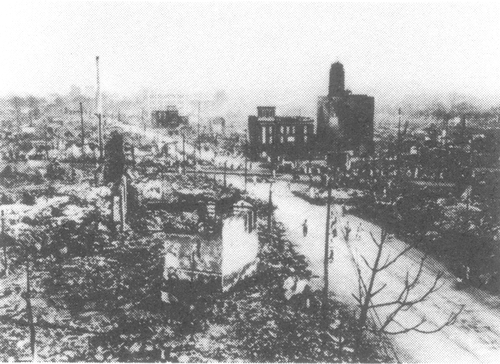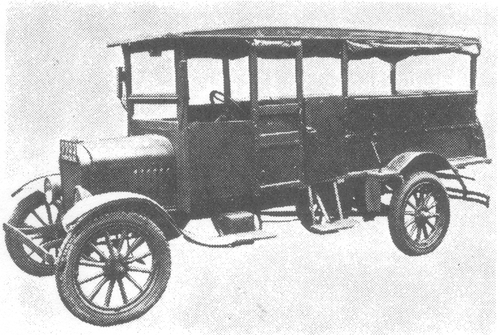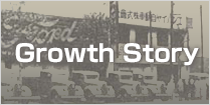
Top > Growth-story > The Great Kanto Earthquake and Development of Auto Business
No.3 The Great Kanto Earthquake and Development of Auto Business
The Great Kanto Earthquake broke out on September 1, 1923, soon after sale of the Ford car had just started.
The fire lasted 3 days and nights, burning everything to the ground. Yanagida building, just completed in 1921, suffered great deal of damage but repair shop at Shibaura was fortunately saved from this earthquake. All the employees worked hard with little sleep or rest for reconstruction, complying with enquiries from the clients in the earthquake- stricken area.

The Great Kanto Earthquake destroyed the railroad, the largest transportation then, and tram car all at once.
The number of tram cars burned down was 779 carriages, 16.25 km of railroad track and 485 cars in the city were damaged. Such a situation caused inconvenience for delivering foodstuffs for rescue operations.
What this disaster had brought about was a rapid and wide-spread motor car and growing demand for manufacturing domestic auto parts.
After the disaster, there was no way but to depend on trucks for collection and distribution of the goods as well as putting things in order for reconstruction works.
Reality of the car industries then was dependent on imports, everything from car body to spare parts and accessories.
The shortage of imported spare parts made people aware of the need for homemade spare parts. This is because number of car increased a lot after the disaster, resulting in supply shortage of spare parts.
In December 1923, Yanagida paid a visit to USA as a representative of Tokyo City in order to return their goodwill shown to a disaster.
On this occasion, he visited Ford Motor Company together with a man who he hired as an interpreter, who then had lived in San Francisco, a man who later became a chairman of the Empire Motor.
Having made little success with Sale Fraser, a Ford Dealer, with whom sales contract had been concluded in Spring, Yanagida negotiated with Ford executives for direct import of spare parts of Ford cars.
Upon his return to Japan, Yanagida started to prepare for getting Ford agency as he had been informed that Ford would soon open Ford Japan aiming at sales expansion in the promising Japanese market as well as Far East market through Ford Japan.
The spare parts division of the company then was selling parts for General Motor cars and also American tools in addition to parts bought from Sale Fraser.
It seemed difficult to obtain Ford agency unless other products than Ford were to be sold separately.
As such was the case, Yanagida had his eyes on a company called “Banzai Trading Company” located just across the road. They were importing oils and other tools for sale but not very successful. Yanagida took over this business and transferred all the products other than Ford to this company. This was a start of present “Banzai Ltd.”

In the meantime, Tokyo Electricity Bureau drew up a project of running a bus business as they thought it difficult to make an early and overall restoration of tramcar.
T-truck chassis of Ford Motor was landed in Yokohama in January, 1924 as a result of an emergency import.
Truck chassis were delivered to major car sales companies where bus bodies were built up on.
Empire Motor cooperated for this work.
There was no manufacturing company for bus bodies then and therefore they were manufactured by those who made horse-drawn carriages. They were shabby, made of wood with a hood.
They reminded of the horse-drawn carriage in the Meiji Era and that this new bus was called Entaro Bus.
It is said that the name originated from a man called Entaro, a comic storyteller, well-known then, who mimicked horse-drawn carriage making sounds by blowing bugle on his stage to make people laugh.
On September 15, 1924, a year after the disaster, an investigating commission from the Ford Motor arrived at Yokohama. The things that had caught their eyes were quite a busy traffic of cars and vigorous reconstruction works, for which they had never thought of. They anticipated that Tokyo should be still burned ruins just a year after the disaster.
It was more surprising to know that leading Japanese business men welcomed for Ford to build its factory in Japan.
Ford Japan, with JPY4 mil. capital, was founded in December 1924.
Advertisement of Ford dealership was published in order to organize nationwide sales network.
They were:
1. To maintain reasonable stock
2. To keep designated showroom and maintenance factory
3. To have capability of selling allotted quantity
In short, dealers were requested to buy allotted quantity of cars under an advanced payment and to keep them in stock, which required them a large sum of funds.
In March, 1925, Empire Motor Company obtained an official agency right of Ford Motor for Tokyo District and started as a Ford Dealer both in name and in reality.
Urgent need for Empire Motor was on 2 above, i.e. to have maintenance factory and to keep large number of genuine parts for the cars sold for one thing and to have showroom completed.
They rented a nearby building where car division and spare parts division were located while hire division used 1st floor of the head office and a half of the 3rd floor and 4th floor were used as a dormitory of the men of single employees. The 2nd floor and a half of the 3rd floor were used as tenant office.
Car models that Empire Motor was entitled to sell were Ford passenger cars, Ford trucks, Fordson tractors and Linchon.
Ford style administration was adopted for the business management of the dealers, new words such as salesman or sales manager were started to be used.
Speaking of the year of 1924 and 1925, corporate bankruptcy, merger and acquisition and inflation were chronic as symptom of Showa Economic Panic.
Under such circumstance, auto sales industry was most popular and forefront runner.










